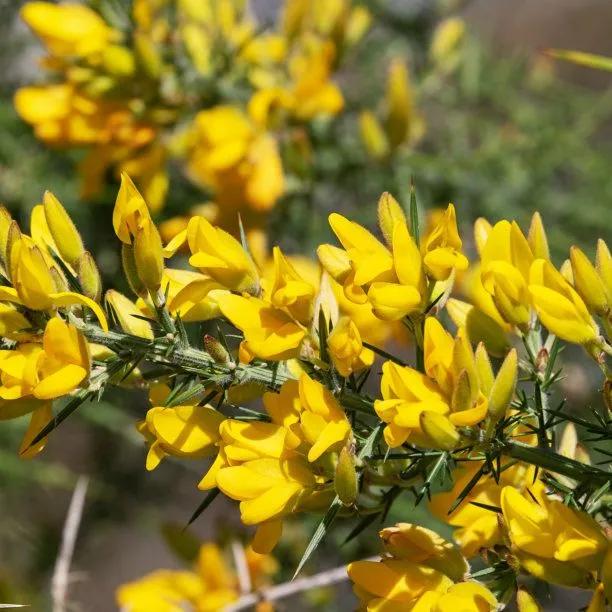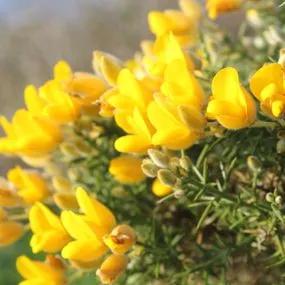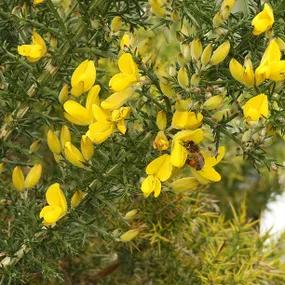Gorse Hedge Plants
The details
Ulex europaeus
Hedge Plants- Native. Thorny. Yellow flowers.
- Rough hedging. Fixes nitrogen.
- Good for dry, poor soil & the coast.
- Max. Height: 3m
- Pot Grown: Year Round Delivery
Recommended extras
Description
Ulex europaeus Hedging
Delivered by Mail Order Direct from our Nursery with a Year Guarantee
Gorse, Ulex europaeus, is a viciously thorny native evergreen bush that makes excellent rough barriers and provides screening up to about 2-3 metres high. It is great for butterflies and small nesting birds as well as providing cover for larger wildlife including deer. As a member of the pea family - you can see this in its flowers - gorse fixes nitrogen from the atmosphere into the soil. This means that it both can grow in very poor terrain and improve it while doing so. Its also has strong wiry roots that anchor it in windswept locations and that help stop soil erosion. Gorse is famous for its striking yellow flowers that blaze open in April and May, with their intoxicatingly fruity scent and are much loved by bees and other pollinators. Gorse is naturally an uneven, lumpy bush, so don't try to clip into a tidy shape; just enjoy it for what it is! You can hard prune down to the ground after flowering if you decide it needs renovating.
Gorse plants are only delivered pot-grown, year round.
All our hedge plants are measured by their height in centimetres above the ground (the roots don't count!).
View our selection of evergreen hedging or see our full range of hedging plants.
Spacing a Gorse hedge:
Plant Gorse at 2 plants per metre, 50cm apart.
History & uses of Ulex europaeus:
The flower buds are edible: pickle them and use them in the same way as capers. Gorse wood is oily and burns very well, although it is too thorny to be a convenient fuel for a hearth fire. Gorse is also called furze or whin.
Planting Instructions
Growing Gorse plants:
This hardy plant will grow in very poor, sandy soils and acidic peat. It must have decent drainage and plenty of sun. It will grow well in exposed coastal sites, but its shape will be flattened by the wind. Mature plants are extremely drought hardy. It can look quite sad after a very harsh winter, but it will regrow vigorously in spring.
It won't grow on chalk.
Gorse is listed as being resistant to honey fungus.
Prepare your site before planting:
Native hedge plants like Gorse are very tough. The only essential preparation is to kill the weeds in a strip a metre wide along the planting site: improving the soil should not be necessary. If your soil is exceptionally poor and dry, then digging in some well rotted manure and/or compost is worthwhile.
Watch our video on how to plant a garden hedge for full details.
Remember to water establishing plants during dry weather for at least a year after planting.
Hedge Planting Accessories:
Prepare your site for planting by killing the weeds and grass with Neudorff WeedFree Plus.
You can buy a hedge planting pack with sheets of mulch fabric and pegs to hold it down.
If your soil quality is poor, we recommend using mycorrhizal "friendly fungi" on the roots of new trees and shrubs.
You can also improve your soil with bonemeal organic fertiliser and Growmore.
Trimming Country hedge plants:
From the winter after planting onwards, your young hedge should be trimmed lightly once every winter, until it is mature. When it is fully grown, you can clip it at anytime. A good time to clip mature Gorse is after flowering.
Special notes on caring for Gorse hedges:
After you have planted your Gorse hedge, the most important thing to do is water it in dry weather. You will also need to weed around the plants. Watering should be thorough, so the ground is soaked. Let the soil almost dry out before watering again. Watering & weeding will be necessary for at least a year after planting.
Like all evergreen plants, Gorse is active and needs moisture in the ground throughout the year. This means that your establishing plants need to be watered in the winter when they are planted, if the weather is dry.
Hygiene & Diseases:
Dead, damaged or diseased wood can be pruned off as soon as it appears.
Disinfect your pruning tools between every cut if there is any sign of disease.
Burn or dispose of any diseased material, do not compost it.




